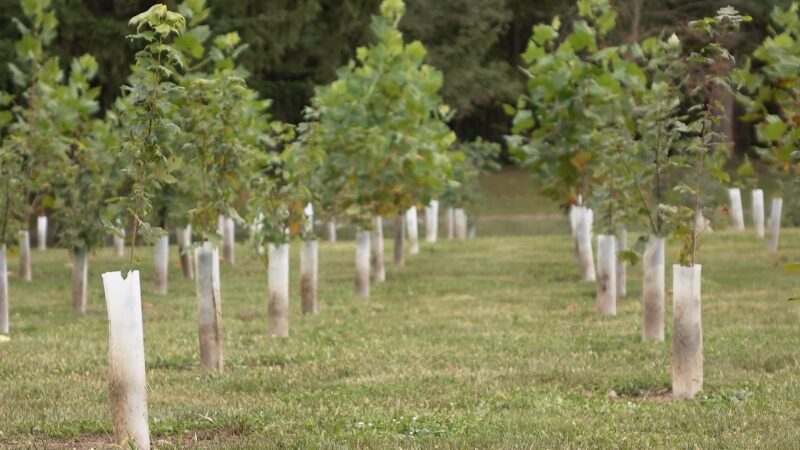As silent sentinels of the earth, trees are deeply influenced by their environmental conditions, from the sweltering heat of tropical climates to the frigid cold of the arctic zones.
Temperature fluctuations, precipitation patterns, and extreme weather events directly impact their physiological processes, stress levels, and susceptibility to diseases and pests.
One of the main concerns is related to climate change, and the consequences nature will face from it. We will analyze more on this topic in the following sections and explain the impact.
It Alters Growth Rates

Climate significantly influences the growth rates of trees. In optimal conditions, trees exhibit robust growth, but when faced with extremes, such as prolonged droughts or excessive rainfall, their growth can be stunted or accelerated in unexpected ways.
Temperature variations, particularly, play a critical role; warmer climates may encourage faster growth in some species, while others may struggle to adapt, leading to reduced growth rings and overall vitality.
Proper treatment is essential for trees to ensure proper growth and state. If you have one in your backyard that is showing some signs of disease and poor condition, a specialized service like Green Drop Tree Care can help.
Impact on Leaf Physiology
The physiology of tree leaves, including aspects like size, thickness, and stomatal behavior, is directly impacted by climatic conditions. High temperatures and intense sunlight can cause leaves to become smaller and thicker, a natural adaptation to reduce water loss.
Conversely, in cooler, more humid environments, leaves might grow larger to maximize photosynthesis. The efficiency of water use and the rate of transpiration are also climate-dependent, affecting how trees manage resources and stress.
Affects Soil Moisture Availability

Soil moisture availability, a critical factor for tree health, is profoundly influenced by climate. Precipitation patterns determine the amount of water entering the soil, while temperature and wind influence the rate of evaporation.
Extended periods of drought diminish soil moisture, challenging trees’ water uptake and leading to stress or even mortality. On the other hand, excessive rainfall can lead to waterlogged conditions, affecting root aeration and nutrient absorption.
Modifies Pest and Disease Prevalence
Climate conditions directly affect the prevalence of pests and diseases that afflict trees. Warmer temperatures can expand the range and activity period of many pests and pathogens, leading to increased infestations and outbreaks.
Humidity and rainfall also play roles, with moist conditions often fostering fungal diseases.
Impacts Nutrient Uptake
Nutrient uptake by trees is closely tied to climate conditions. Temperature and moisture levels influence soil chemistry, microbial activity, and the availability of essential nutrients like nitrogen and phosphorus.
In colder climates, nutrient cycling slows down, limiting tree growth. Conversely, in warmer, wetter conditions, increased microbial activity can enhance nutrient availability but also lead to faster nutrient depletion.
Triggers Stress Responses

Trees exhibit various stress responses to adverse climate conditions, such as extreme temperatures, drought, or excessive moisture. These responses include altering water usage, shutting down photosynthesis to conserve resources, and producing protective chemicals.
Such mechanisms are vital for survival but can also limit growth and reproductive capacity. Over time, chronic stress can weaken trees, making them more susceptible to disease and pests, and reducing their overall lifespan.
Determines Survival and Distribution
The survival and distribution of tree species are fundamentally determined by climate. Each species has specific climatic requirements for optimal growth, beyond which survival rates decline.
Temperature and precipitation patterns dictate where certain trees can thrive, leading to distinct biomes, such as tropical rainforests, temperate forests, and boreal forests. Climate change is shifting these patterns, forcing tree populations to adapt, migrate, or face extinction.
Influences Flowering and Fruiting Times
The timing of flowering and fruiting in trees is intricately linked to climate cues. Temperature, light, and moisture levels trigger these critical phases of a tree’s life cycle, which are essential for reproduction and species survival.
Climate change is altering these cues, leading to mismatches in timing that can affect pollination success and seed dispersal.
Such changes can disrupt food webs and have cascading effects on ecosystems. Monitoring and understanding these shifts are crucial for conservation and management strategies.
Affects Photosynthesis Efficiency
Photosynthesis, the process by which trees convert sunlight into energy, is highly sensitive to climate. Temperature, light intensity, and CO2 levels directly influence photosynthesis rates.
Optimal conditions can enhance photosynthesis, leading to greater growth and carbon sequestration. However, extreme heat or cold can reduce efficiency, impacting tree health and growth.
Additionally, changing atmospheric CO2 concentrations can affect photosynthetic rates, with potential implications for tree physiology and forest ecosystems’ carbon dynamics.
Modifies Fire Frequency and Intensity
Climate has a profound impact on fire regimes, affecting the frequency, intensity, and extent of wildfires. Drier, warmer conditions increase the likelihood of fires, making forests more susceptible to large-scale burn events.
These fires can be both destructive and regenerative, clearing old growth and making way for new. However, increased fire activity can also lead to loss of tree species less adapted to fire, altering forest composition and structure.
Shapes Genetic Diversity

Climate exerts a significant influence on the genetic diversity within tree populations. Environmental pressures and climatic conditions drive natural selection, shaping the genetic makeup of trees to better adapt to their habitats.
This evolutionary process ensures that tree species can cope with changes in temperature, moisture, and other climatic factors, enhancing their resilience to environmental stresses. Genetic diversity is crucial for the long-term survival of species, enabling adaptation to changing climates and resistance to diseases and pests.
Similarly, just as trees evolve to thrive in diverse environments, animals like opossums have developed unique strategies, such as entering a state of torpor, to successfully navigate the challenges posed by winter conditions.
Conclusion
We need to be more aware and active in taking care of the environment because climate change is evidently harming trees.
As we face the realities of climate change, the health of our trees becomes a clear indicator of the broader health of our planet. Protecting and nurturing these vital natural resources requires informed conservation strategies and proactive measures to mitigate climate impacts.
By prioritizing tree health, we not only preserve the biodiversity and ecological balance of our forests but also reinforce the resilience of our global ecosystem against the challenges of a changing climate. This commitment to tree health is a fundamental step towards a sustainable future for all.








